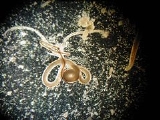
Strongylida
Encyclopedia
The Suborder Strongylida includes many of the important nematode
s found in the gastrointestinal tract
s of ruminant
s, horse
s, and swine, as well as the lungworm
s of ruminant
s and, the hookworm
s of dog
s and cat
s.
This Suborder includes (Superfamily - included Families):
Nematode
The nematodes or roundworms are the most diverse phylum of pseudocoelomates, and one of the most diverse of all animals. Nematode species are very difficult to distinguish; over 28,000 have been described, of which over 16,000 are parasitic. It has been estimated that the total number of nematode...
s found in the gastrointestinal tract
Gastrointestinal tract
The human gastrointestinal tract refers to the stomach and intestine, and sometimes to all the structures from the mouth to the anus. ....
s of ruminant
Ruminant
A ruminant is a mammal of the order Artiodactyla that digests plant-based food by initially softening it within the animal's first compartment of the stomach, principally through bacterial actions, then regurgitating the semi-digested mass, now known as cud, and chewing it again...
s, horse
Horse
The horse is one of two extant subspecies of Equus ferus, or the wild horse. It is a single-hooved mammal belonging to the taxonomic family Equidae. The horse has evolved over the past 45 to 55 million years from a small multi-toed creature into the large, single-toed animal of today...
s, and swine, as well as the lungworm
Lungworm
Lungworms are parasitic nematode worms of the order Strongylida that infest the lungs of vertebrates. The name is used for a variety of different groups of nematodes, some of which also have other common names; what they have in common is that they migrate to their hosts' lungs or respiratory...
s of ruminant
Ruminant
A ruminant is a mammal of the order Artiodactyla that digests plant-based food by initially softening it within the animal's first compartment of the stomach, principally through bacterial actions, then regurgitating the semi-digested mass, now known as cud, and chewing it again...
s and, the hookworm
Hookworm
The hookworm is a parasitic nematode that lives in the small intestine of its host, which may be a mammal such as a dog, cat, or human. Two species of hookworms commonly infect humans, Ancylostoma duodenale and Necator americanus. A. duodenale predominates in the Middle East, North Africa, India...
s of dog
Dog
The domestic dog is a domesticated form of the gray wolf, a member of the Canidae family of the order Carnivora. The term is used for both feral and pet varieties. The dog may have been the first animal to be domesticated, and has been the most widely kept working, hunting, and companion animal in...
s and cat
Cat
The cat , also known as the domestic cat or housecat to distinguish it from other felids and felines, is a small, usually furry, domesticated, carnivorous mammal that is valued by humans for its companionship and for its ability to hunt vermin and household pests...
s.
This Suborder includes (Superfamily - included Families):
- Ancylostomatoidea
- AncylostomatidaeAncylostomatidaeAncylostomatidae is a family of worms that includes the hookworms.- Genera of Ancylostomatidae :* Agriostomum* Ancylostoma* Cyclodontostomum* Galonchus*Monodontus*Necator...
- Ancylostomatidae
- Diaphanocephaloidea
- Diaphanocephalidae
- Heligmosomoidea
- Heligmosomidae
- Metastrongyloidea
- Angiostrongylidae
- Crenosomatidae
- Filaroididae
- MetastrongylidaeMetastrongylidaeMetastrongylidae is a family of nematodes.Genera in the family Metastrongylidae include:* Aelurostrongylus*Metastrongylus*Skrjabingylus...
- Protostrongylidae
- Pseudaliidae
- SyngamidaeSyngamidaeSyngamidae is a family of nematodes which commonly parasitize mammals, birds, and rarely humans. They are classified in the Strongyloidae superfamily and Strongylata order ....
- Molineoidea
- Molineidae
- Strongyloidea
- Chabertiidae
- Cloacinidae
- Deletrocephalidae
- Stephanuridae
- Stronylidae
- Trichostrongyloidea
- Amidostomatidae
- Cooperiidae
- Dictyocaulidae
- Dromaeostrongylidae
- Haemonchidae
- Heligmonellidae
- Heligmosomatidae
- Herpetostrongylidae
- Mackerrasrtongylidae
- Nicollinidae
- Trichostrongylidae

